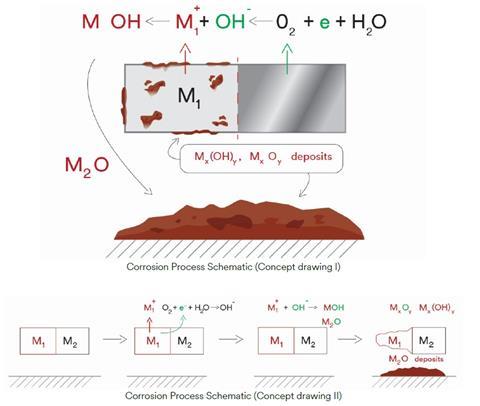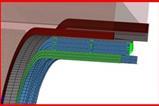Rolling stock manufacturers are constantly seeking more sustainable and cost-effective solutions to build and maintain railcars for the long term. Of the many unique obstacles faced in the rail industry, corrosion is among the most common – and costly. Preventing corrosion in rolling stock has been a core concern of railway engineering since the industry began.
This paper provides a detailed overview of corrosion in the rail industry. It explores the science behind corrosion, surveys common types of corrosion seen in rail applications (galvanic, pitting, etc.) and considers various methods to protect rolling stock from corrosive environments. In the conclusion, 3M™ Graphic Films are highlighted as a powerful and cost-effective alternative to other coating methods delivering exceptional benefits such as reduced weight, labor costs and environmental impact.
What is corrosion?
Corrosion is the deterioration of materials resulting from an electromechanical attack on metals. While factors such as mechanical stress and erosion can be contributing factors, the main cause of corrosion is the chemical reaction with a liquid electrolyte or the environment to form metal oxides. Metals are susceptible to corrosion due to their possession of free electrons that produce electrochemical cells within their structure.
To understand corrosion, it is important to know how metals typically exist in nature. Most metals exist as low-energy-state compounds compared to their high-energy metallic counterparts. For example, iron oxide (i.e., rust) and aluminum oxide (i.e., alumina) are low-energy-state compounds of iron and aluminum respectively. Due to their free electrons, metals in their high-energy states tend to chemically react with their environment (e.g., water and atmosphere), becoming more stable by forming low-energy-state compounds. The resulting metal oxide has markedly different mechanical and electrical properties than the original metal compound.

How does corrosion affect aluminum and iron?
In the case of aluminum, water-insoluble aluminum oxide (alumina) forms as a hard solid on the surface of the metal and tends to inhibit further corrosion of the aluminum underneath. Thus, environmental aluminum corrosion is of little structural concern; the primary result is simply a discoloration at the metal surface. There are well-known examples of aluminum coaches such as the Ginza Line in Tokyo, Japan that have been in operation since 2012.
Steel undergoes a similar oxidation process. However, unlike aluminum oxide, the density decrease of iron oxide causes mechanical property deterioration at the surface of the metal. Iron oxide flakes off the surface over time, exposing fresh iron to continued oxidation and contributing to erosion of the entire iron mass. Iron corrosion is therefore a critical concern and has been for hundreds of years. Historical examples range from iron swords chipping or breaking in battle to bridges and other structures failing catastrophically during use.
What are common types of corrosion seen in rail applications?
Galvanic [bimetallic] corrosion
When two metals of different redox potential are put into contact – such as using steel screws to fasten aluminum panels – a specific type of corrosion occurs, accelerating the degradation of the metal with the higher electrical potential. This is called galvanic, bimetallic or dissimilar metal corrosion. In such cases, the metal with higher corrosion is the anode in a cathode/anode cell (see figure).
Pitting corrosion
This form of corrosion is caused by a localized attach that creates pits (small holes) in the metal surface. Pitting typically occurs in aggressive corrosive environments and usually requires an initiation period. Pits are initiated in places where local increases in corrosion rates occur. Inclusions and other structural and compositional heterogeneities on the metal surface are common places where pits are initiated. Such places allow high-acid-concentration anodes to build up, creating an autocatalytic process in which corrosion occurs. Pitting corrosion can be destructive if perforations are formed through the metal. If perforations do not occur, a limited amount of pitting corrosion can be acceptable.
Crevice corrosion
Crevice corrosion is an electrochemical corrosion process localized in areas where a crevice is large enough for moisture to enter but not escape. Crevice corrosion is similar to pitting corrosion: a buildup of acid from cathodic and anodic reactions breaks down the metal, causing corrosion.
Filiform corrosion
Filiform corrosion is a type of crevice corrosion that may occur when metals are coated with a water-permeable organic coating and exposed to a corrosive solution. Caused by coating defects, areas with low coating thickness or impurities of the metal, filiform corrosion resembles worm-like tracks that propagate from the interface of the coating and the metal layer, typically in one direction. The head of the track is active and acidic, while the tail is in contact with the air and of an alkaline nature. Filiform corrosion can specifically occur at elevated temperatures of up to 40 °C (104 °F) in high relative humidity and in the presence of chloride ions. In coastal areas, however, it has been known to occur at lower temperatures. Filiform corrosion is a superficial type of defect that does not harm the structural stability of a construction. However, it may have a significant impact on visual appearance.
Stress corrosion
Stress corrosion results from the effects of tensile stress in a specific corrosive environment that causes localized electromechanical corrosion. It occurs at the tip of a crack and propagates until the stress or corrosion is stopped. Aluminum alloys can undergo stress corrosion in environments such as NaCl-H2O2 solutions, NaCl solutions, seawater air and water vapor. Stainless steels can experience stress corrosion in similar acid-chlorine solutions.

How can corrosion be prevented?
Since environmental exposure is necessary for corrosion to progress, corrosion prevention involves factors such as proper material selection, coating, design and environmental protection. Selecting the correct material for the application is crucial. Understanding the environmental conditions to which the material will be subjected will help ensure proper material selection.
Coatings such as metallic plating and other organic polymeric materials can also be applied to metals to protect them from corrosive environments. Metallic plating is the process of applying a thin protective metal layer on top of the bulk metal to separate it from the corrosive environment. Organic coatings such as films, paint, primer and other organic polymeric materials can be used to protect from corrosion. It is crucial that the underlying surface is well prepared prior to properly applying the coating, as damaged coatings can lead to corrosion.
Design and specification of materials are crucial factors in the railcar manufacturing process. The following general guidelines can help reduce the likelihood of corrosion.
- When joining metal components, weld them together rather than rivet. This reduces the chance for water to build up and cause crevice corrosion. Where rivets are necessary, ensure that they are cathodic to the material being used.
- Use galvanically similar materials when designing the components. If dissimilar metals are used, ensure they are separated or spaced with materials that prevent electrical contact. Seals and gaskets can be used to separate dissimilar metals.
- Ensure surfaces have proper drainage and cleanability to prevent liquids from pooling and potentially forming a galvanic cell.
- Where components may be susceptible to corrosion, design them to be easily removed and replaced.
The environment greatly determines the severity of corrosion. It is important to fully understand the various environmental conditions to which the railcar will be subjected.
How 3M™ Graphic Films can help
Corrosion presents fundamental challenges to rolling stock design and manufacture. It arises from a variety of material and environmental factors and can dramatically weaken the structural integrity of railcars while affecting visual appearance. While paint coatings have long been used to shield rolling stock from environmental exposure and prevent corrosion, they have several notable drawbacks. These include high maintenance costs, added weight due to multiple coatings, and appreciable VOC (Volatile organic compound) emissions.
3M™ Graphic Films offer a powerful alternative to paint coatings, with reductions in labor, weight and environmental impact. Graphic films can help eliminate the need for paint coatings while delivering all the same benefits: protection from corrosive environments, durability, resistance to peeling and fading, and more. They are easy to apply, maintain and replace, helping streamline the rolling stock manufacturing process. To learn more about how graphic films can meet your design needs, contact a 3M representative or visit the 3M Rail Solutions website.
Sources
Fontana, M. G., and N. D. Greene. Corrosion Engineering. 2nd ed. New York: McGraw Hill, 1978.
Smith, William F., et al. Foundations of Materials Science and Engineering. New York: McGraw Hill, 2011.
Vargel, Christian. http://www.corrosion-aluminium.com. In Corrosion of Aluminium, 2004.
Wikipedia. “Filiformkorrosion.” Last modified May 26, 2017. Filiformkorrosion – Wikipedia.






















